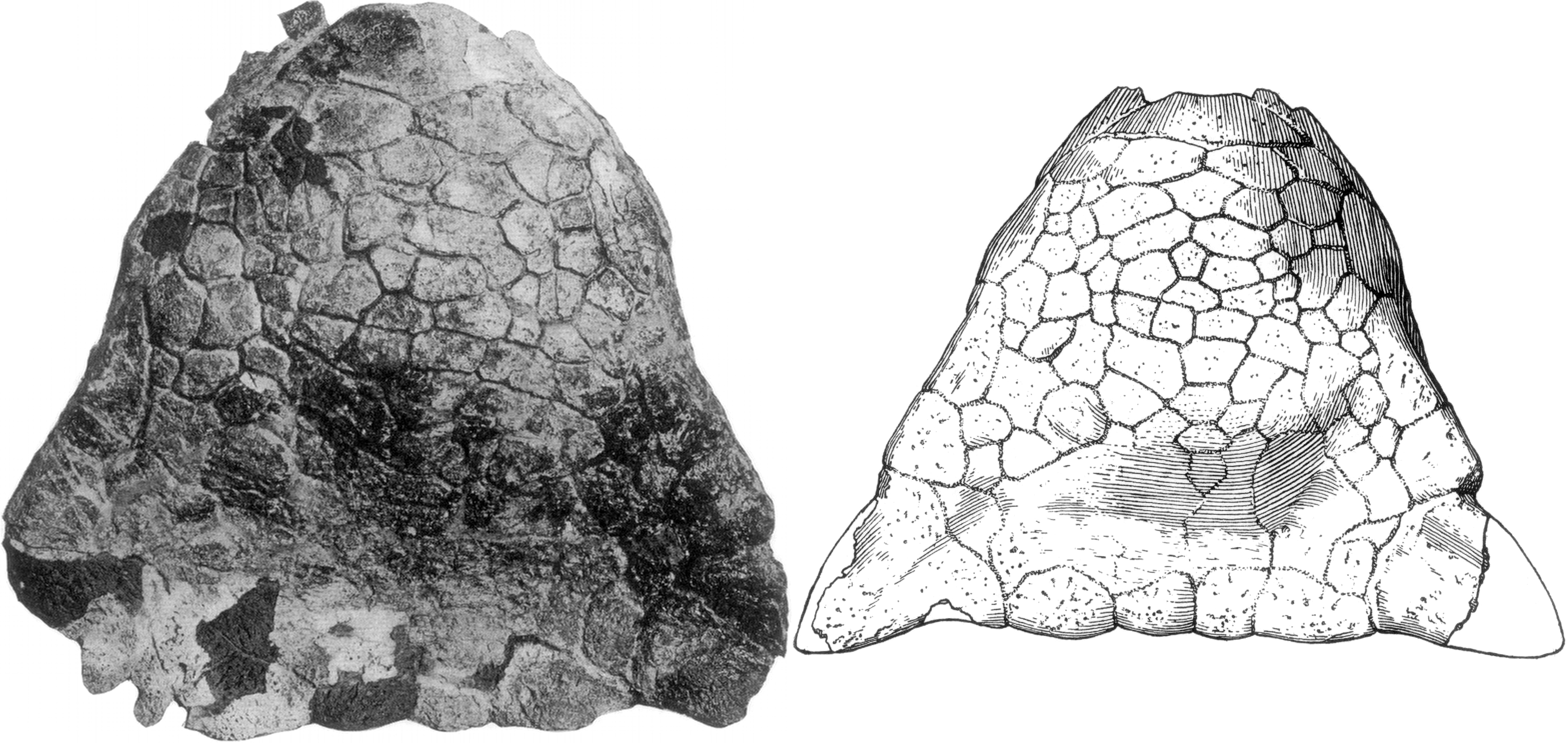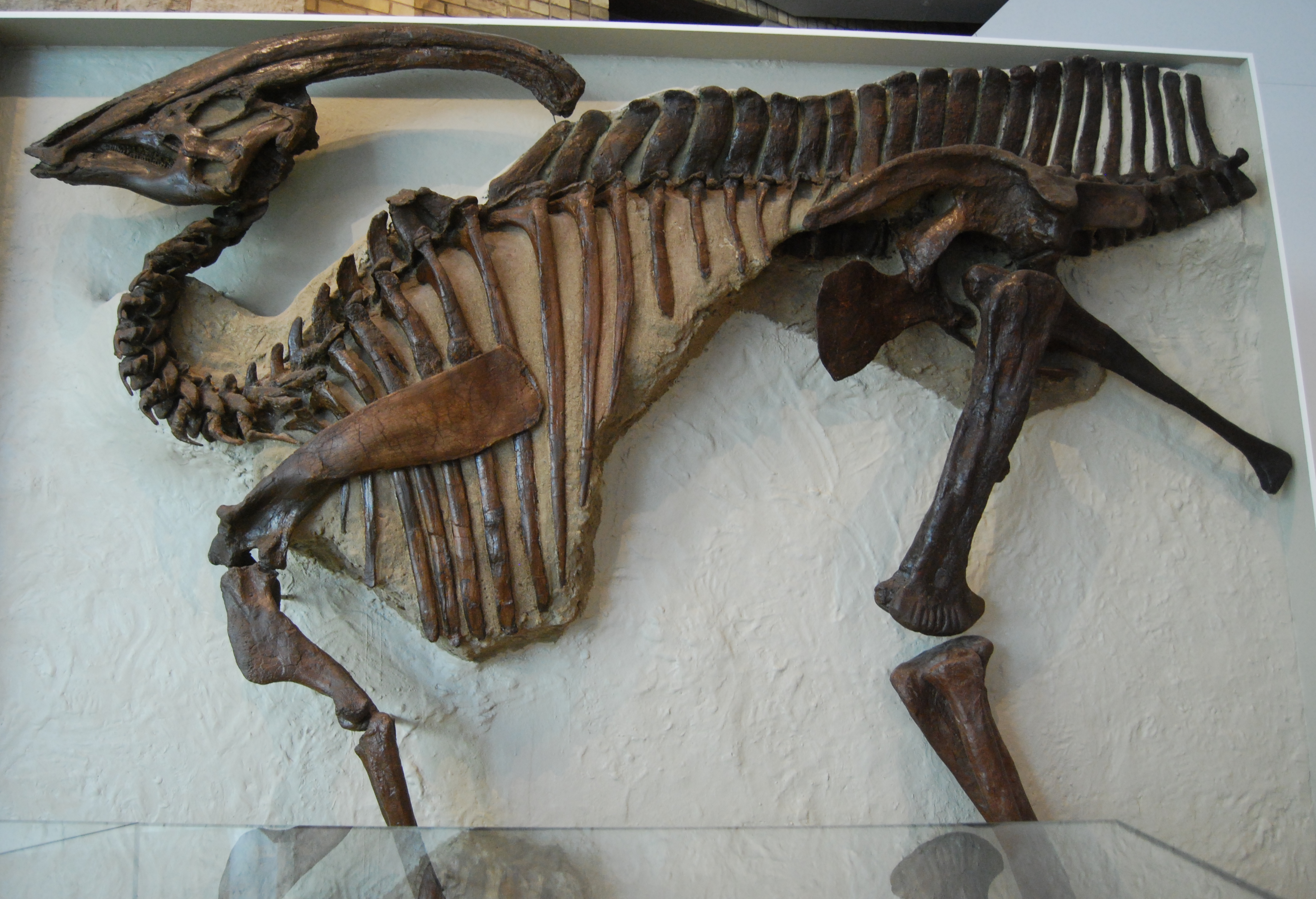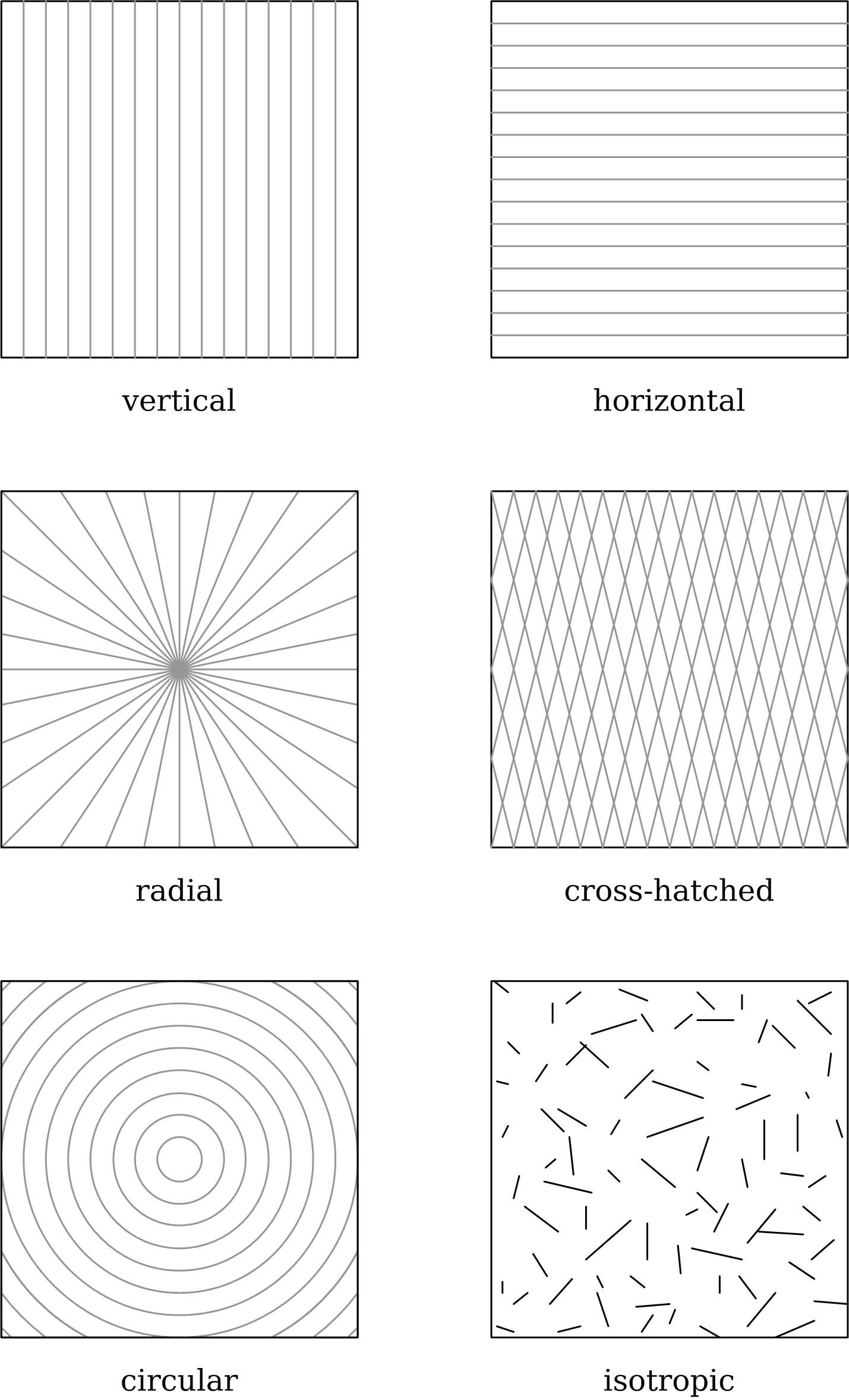|
Nodocephalosaurus
''Nodocephalosaurus'' (meaning "knob headed lizard") is a monospecific genus of ankylosaurid dinosaur from New Mexico that lived during the Late Cretaceous (late Campanian to early Maastrichtian stage, 73.49 to 73.04 Ma) in what is now the De-na-zin member of the Kirtland Formation. The type and only species, ''Nodocephalosaurus kirtlandensis'', is known only from a partial skull. It was named in 1999 by Robert M. Sullivan. ''Nodocephalosaurus'' has an estimated length of 4.5 metres (15 feet) and weight of 1.5 tonnes (3,306 lbs).Paul, G.S., 2016, ''The Princeton Field Guide to Dinosaurs 2nd Edition'', Princeton University Press It is closely related and shares similar cranial anatomy to ''Akainacephalus''. Discovery and naming In 1995, a partial skull of an ankylosaur was discovered weathering out of a grey mudstone a few hundred metres west of a new ''Parasaurolophus'' site in the De-na-zin member of the Kirtland Formation, New Mexico. Robert M. Sullivan and Thomas E. Willia ... [...More Info...] [...Related Items...] OR: [Wikipedia] [Google] [Baidu] |
Akainacephalus
''Akainacephalus'' (meaning "thorn head") is a monospecific genus of ankylosaurid dinosaur from southern Utah that lived during the Late Cretaceous (late Campanian, 76.26 Ma) in what is now the Horse Mountain Gryposaur Quarry of the Kaiparowits Formation. The type and only species, ''Akainacephalus johnsoni'', is known from the most complete ankylosaur specimen ever discovered from southern Laramidia, including a complete skull, tail club, a number of osteoderms, limb elements and part of its pelvis, among other remains. It was described in 2018 by Jelle P. Wiersma and Randall B. Irmis. It is closely related and shares similar cranial anatomy to ''Nodocephalosaurus''. Discovery and naming An almost complete skeleton of an ankylosaurid was excavated during the 2008, 2009, and 2010 field seasons from the Horse Mountain Gryposaur (HMG) Quarry in the Grand Staircase–Escalante National Monument, Kane County, Utah. The Horse Mountain Gryposaur Quarry represents a multitaxic and mult ... [...More Info...] [...Related Items...] OR: [Wikipedia] [Google] [Baidu] |
Ziapelta
''Ziapelta'' is an extinct genus of ankylosaurid. Its fossils have been found in the Hunter Wash and De-na-zin members of the Kirtland Formation of Upper Cretaceous (Campanian) New Mexico. It was named in 2014, in a research paper led by ankylosaur researcher Victoria Arbour. There is a single species in the genus, ''Ziapelta sanjuanensis.'' The genus is named after the Zia sun symbol, a stylized sun with four groups of rays, having religious significance to the Zia people of New Mexico, and the iconic symbol on the state flag of New Mexico, and ''pelta'' (Latin), a small shield, in reference to the osteoderms found on all ankylosaurids. The specific name is in reference to San Juan County and the San Juan basin, where the fossils were found. Multiple specimens have been described to date, though the fossils are mostly from the front part of the animal. The adult length of ''Ziapelta'' is estimated at between and long, depending on whether the holotype was full-grown. It ... [...More Info...] [...Related Items...] OR: [Wikipedia] [Google] [Baidu] |
Ziapelta Sanjuanensis 0108804 G001
''Ziapelta'' is an extinct genus of ankylosaurid. Its fossils have been found in the Hunter Wash and De-na-zin members of the Kirtland Formation of Upper Cretaceous (Campanian) New Mexico. It was named in 2014, in a research paper led by ankylosaur researcher Victoria Arbour. There is a single species in the genus, ''Ziapelta sanjuanensis.'' The genus is named after the Zia sun symbol, a stylized sun with four groups of rays, having religious significance to the Zia people of New Mexico, and the iconic symbol on the state flag of New Mexico, and ''pelta'' (Latin), a small shield, in reference to the osteoderms found on all ankylosaurids. The specific name is in reference to San Juan County and the San Juan basin, where the fossils were found. Multiple specimens have been described to date, though the fossils are mostly from the front part of the animal. The adult length of ''Ziapelta'' is estimated at between and long, depending on whether the holotype was full-grown. It w ... [...More Info...] [...Related Items...] OR: [Wikipedia] [Google] [Baidu] |
Ankylosauridae
Ankylosauridae () is a family of armored dinosaurs within Ankylosauria, and is the sister group to Nodosauridae. The oldest known Ankylosaurids date to around 122 million years ago and went extinct 66 million years ago during the Cretaceous–Paleogene extinction event. These animals were mainly herbivorous and were obligate quadrupeds, with leaf-shaped teeth and robust, scute-covered bodies. Ankylosaurids possess a distinctly domed and short snout, wedge-shaped osteoderms on their skull, scutes along their torso, and a tail club. Ankylosauridae is exclusively known from the northern hemisphere, with specimens found in western North America, Europe, and East Asia. The first discoveries within this family were of the genus '' Ankylosaurus'', by Peter Kaiser and Barnum Brown in Montana in 1906. Brown went on to name Ankylosauridae and the subfamily Ankylosaurinae in 1908. Anatomy Ankylosaurids are stout, solidly built, armoured dinosaurs. They possess accessory ossifications ... [...More Info...] [...Related Items...] OR: [Wikipedia] [Google] [Baidu] |
Ankylosauridae
Ankylosauridae () is a family of armored dinosaurs within Ankylosauria, and is the sister group to Nodosauridae. The oldest known Ankylosaurids date to around 122 million years ago and went extinct 66 million years ago during the Cretaceous–Paleogene extinction event. These animals were mainly herbivorous and were obligate quadrupeds, with leaf-shaped teeth and robust, scute-covered bodies. Ankylosaurids possess a distinctly domed and short snout, wedge-shaped osteoderms on their skull, scutes along their torso, and a tail club. Ankylosauridae is exclusively known from the northern hemisphere, with specimens found in western North America, Europe, and East Asia. The first discoveries within this family were of the genus '' Ankylosaurus'', by Peter Kaiser and Barnum Brown in Montana in 1906. Brown went on to name Ankylosauridae and the subfamily Ankylosaurinae in 1908. Anatomy Ankylosaurids are stout, solidly built, armoured dinosaurs. They possess accessory ossifications ... [...More Info...] [...Related Items...] OR: [Wikipedia] [Google] [Baidu] |
Kirtland Formation
The Kirtland Formation (originally the Kirtland Shale) is a sedimentary geological formation. Description The Kirtland Formation is the product of alluvial muds and overbank sand deposits from the many channels draining the coastal plain that existed on the inland seashore of North America, in the late Cretaceous period. It overlies the Fruitland Formation. It is found in the San Juan Basin in the states of New Mexico and Colorado, in the United States of America. The base of the Kirtland Formation and its lowest sub-unit, the Hunter Wash member, has been dated to 75.02 ± 0.13 Ma. Together with the upper part of the underlying Fruitland Formation, this contains fossils representing the Hunter Wash local fauna. The border between the Hunter Wash member and overlying Farmington member dates to approximately 74 million years ago. The top of the Farmington member and bottom of the overlying De-na-zin member has been radiometrically dated to 73.83 ± 0.18 Ma ago. The to ... [...More Info...] [...Related Items...] OR: [Wikipedia] [Google] [Baidu] |
Parasaurolophus
''Parasaurolophus'' (; meaning "near crested lizard" in reference to ''Saurolophus)'' is a genus of herbivorous hadrosaurid ornithopod dinosaur that lived in what is now North America and possibly Asia during the Late Cretaceous Period, about 76.5–73 million years ago. It was a herbivore that walked both as a biped and as a quadruped. Three species are universally recognized: ''P. walkeri'' (the type species), ''P. tubicen'', and the short-crested ''P. cyrtocristatus''. Additionally, a fourth species, ''P. jiayinensis'', has been proposed, although it is more commonly placed in the separate genus '' Charonosaurus''. Remains are known from Alberta (Canada), New Mexico and Utah (United States), and possibly Heilongjiang (China). The genus was first described in 1922 by William Parks from a skull and partial skeleton found in Alberta. ''Parasaurolophus'' was a hadrosaurid, part of a diverse family of Cretaceous dinosaurs known for their range of bizarre head adornmen ... [...More Info...] [...Related Items...] OR: [Wikipedia] [Google] [Baidu] |
Ahshislepelta
''Ahshislepelta'' (meaning "Ah-shi-sle-pah Wash shield") is a monospecific genus of ankylosaur dinosaur from New Mexico that lived during the Late Cretaceous (late Campanian stage, 74.5 Ma) in what is now the Hunter Wash Member of the Kirtland Formation. The type and only species, ''Ahshislepelta minor'', is known only from an incomplete postcranial skeleton of a small subadult or adult individual. It was named in 2011 by Michael Burns and Robert M. Sullivan. Based on the size of the humerus, ''Ahshislepelta'' is larger than '' Pinacosaurus mephistocephalus'' but smaller than ''Talarurus'' and ''Pinacosaurus grangeri''. Discovery and naming In 2005, a partial postcranial skeleton of an ankylosaur was discovered from the Hunter Wash Member in the lower part of the Kirtland Formation, New Mexico at the Ah-shi-sle-pah Wilderness Study Area. The specimen was later collected over consecutive field seasons from 2005 to 2009 and was subsequently described in 2011 by Michael Burns an ... [...More Info...] [...Related Items...] OR: [Wikipedia] [Google] [Baidu] |
Late Cretaceous
The Late Cretaceous (100.5–66 Ma) is the younger of two epochs into which the Cretaceous Period is divided in the geologic time scale. Rock strata from this epoch form the Upper Cretaceous Series. The Cretaceous is named after ''creta'', the Latin word for the white limestone known as chalk. The chalk of northern France and the white cliffs of south-eastern England date from the Cretaceous Period. Climate During the Late Cretaceous, the climate was warmer than present, although throughout the period a cooling trend is evident. The tropics became restricted to equatorial regions and northern latitudes experienced markedly more seasonal climatic conditions. Geography Due to plate tectonics, the Americas were gradually moving westward, causing the Atlantic Ocean to expand. The Western Interior Seaway divided North America into eastern and western halves; Appalachia and Laramidia. India maintained a northward course towards Asia. In the Southern Hemisphere, Australia a ... [...More Info...] [...Related Items...] OR: [Wikipedia] [Google] [Baidu] |
Surface Finish
Surface finish, also known as surface texture or surface topography, is the nature of a surface as defined by the three characteristics of lay, surface roughness, and waviness.. It comprises the small, local deviations of a surface from the perfectly flat ideal (a true plane). Surface texture is one of the important factors that control friction and transfer layer formation during sliding. Considerable efforts have been made to study the influence of surface texture on friction and wear during sliding conditions. Surface textures can be isotropic or anisotropic. Sometimes, stick-slip friction phenomena can be observed during sliding, depending on surface texture. Each manufacturing process (such as the many kinds of machining) produces a surface texture. The process is usually optimized to ensure that the resulting texture is usable. If necessary, an additional process will be added to modify the initial texture. The latter process may be grinding (abrasive cutting), pol ... [...More Info...] [...Related Items...] OR: [Wikipedia] [Google] [Baidu] |
Gregory S
Gregory may refer to: People and fictional characters * Gregory (given name), including a list of people and fictional characters with the given name * Gregory (surname), a surname Places Australia * Gregory, Queensland, a town in the Shire of Burke **Electoral district of Gregory, Queensland, Australia * Gregory, Western Australia. United States * Gregory, South Dakota * Gregory, Tennessee * Gregory, Texas Outer space * Gregory (lunar crater) * Gregory (crater on Venus) Other uses * "Gregory" (''The Americans''), the third episode of the first season of the television series ''The Americans'' See also * Greg (other) * Greggory * Gregoire (other) * Gregor (other) * Gregores (other) * Gregorian (other) * Gregory County (other) * Gregory Highway, Queensland * Gregory National Park, Northern Territory * Gregory River in the Shire of Burke, Queensland * Justice Gregory (other) * Lake Gregory (other) L ... [...More Info...] [...Related Items...] OR: [Wikipedia] [Google] [Baidu] |
Caudal Vertebrae
The spinal column, a defining synapomorphy shared by nearly all vertebrates, Hagfish are believed to have secondarily lost their spinal column is a moderately flexible series of vertebrae (singular vertebra), each constituting a characteristic irregular bone whose complex structure is composed primarily of bone, and secondarily of hyaline cartilage. They show variation in the proportion contributed by these two tissue types; such variations correlate on one hand with the cerebral/caudal rank (i.e., location within the backbone), and on the other with phylogenetic differences among the vertebrate taxa. The basic configuration of a vertebra varies, but the bone is its ''body'', with the central part of the body constituting the ''centrum''. The upper (closer to) and lower (further from), respectively, the cranium and its central nervous system surfaces of the vertebra body support attachment to the intervertebral discs. The posterior part of a vertebra forms a vertebral ar ... [...More Info...] [...Related Items...] OR: [Wikipedia] [Google] [Baidu] |










